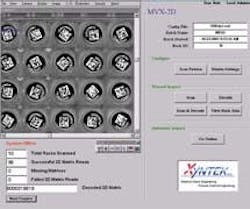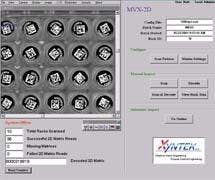Scanning system reads medical vial barcodes
In the biopharmaceutical industry, individual vials need to be tracked as they are filled with reagent and moved to the next stage of a biomedical-analysis process. To do so, many pharmaceutical suppliers mark each one of the 96 vials in the 12 x 8 cassette carrier with a DataMatrix code to perform a computer-based audit-tracking procedure.
To automatically track these vials, both RVSI Acuity (Canton, MA) and Xyntek Inc. (Yardley, PA) offer systems that read the data matrix code and output the information to PC-compatible database packages for further analysis. In its approach, RVSI developed a custom vial scanner that is interfaced to its Visionscape Express system. Like the RVSI system, the Xyntek MVX-2D is intended for batch reading of matrix codes and management of microplates and tube racks used in high-throughput vial-screening applications. However, unlike RVSI's custom scanner, the PC-based Xyntek system is based on an open-architecture design that can be configured with a number of high-resolution flatbed scanners from companies such as Hewlett-Packard (Palo Alto, CA) and Microtek (Hsinchu, Taiwan).
In operation, a rack containing the 96 vials is placed in a fixed position on the scanner with vial 1,1 in the upper left corner. After an image of all the matrix symbols is scanned into the system from the bottom surfaces of all the vials, the image is transferred to a PCI-based Series 8000 board from Cognex Corp. (Natick, MA). "Using the OMI Vision tools supplied with the board," says Mac Hashemian of Xyntek, the MVX-2D performs matrix decoding with a user-friendly GUI." The MVX-2D system then reads the symbols using a search box that follows a predefined grid. Using a search algorithm, each symbol is located prior to reading and decoded regardless of vial rotation. "In the MVX-2D graphical-interface environment, the user can make adjustments to the decoding grid rows, columns, and spacings. This permits the system to be configured for reading practically any grid of matrix codes," Hashemian says.
The inspection cycle of the MVX-2D system is composed of image acquisition and decoding. Acquiring the image requires about 45 s using a flatbed scanner, while the Cognex image processor can decode images at rates as fast as 2000/min.
To receive external triggers and send a pass/fail response, the system's digital I/O can be interfaced with third-party robotic systems. In such a system, a robot would place a 96-tube rack on the flatbed scanner and trigger the digital input. The system would then perform a scan and decode cycle and set the digital output to indicate that the decoding was successful. Decoded symbol data for all the vials in each rack would then be automatically stored to a database file with timestamp, rack number, tube coordinates, and batch code. Because the data are stored in an open format, it can be queried by other systems for further integration with information management systems.

